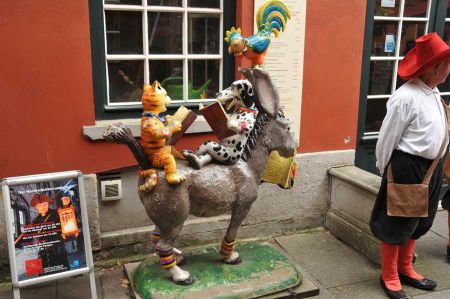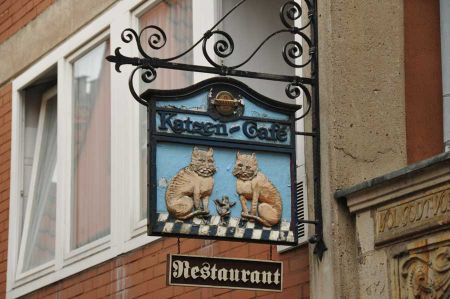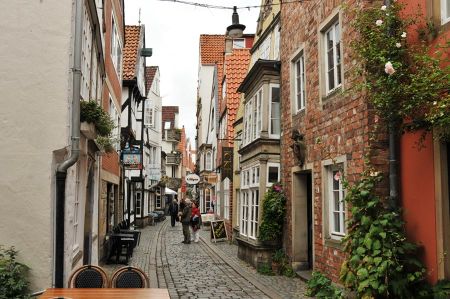Bremen's Schnoor district and famous Böttcher Street
- Written by Portal Editor
After a short break at a food stand near the Bremen Town Hall, we made our way to the, at least historically considered, probably oldest and most famous Bremen district, the Schnoor district.
In the 13th century already records were made for the first time, in which the Schnoor settlement on the edge of the Franciscan monastery, of which just the monastery church is preserved unfortunately, is shown. The term Schnoor comes from the Lower German language in the sense Snoor equal string. This refers to the narrow, narrow lanes, on which the small settlement houses line up on both sides left and right. So it is hardly surprising that one of the streets also bears the name "Schnoor".
Narrow streets characterize the image of the Schnoor district

Another example is the street name "Stavendamm", where the first public bathhouse was located. In Lower German "Stave" means a room / a living room. But in here you could get several other types of pleasures, besides bathing. Behind closed doors, people whispered even about a secret passage to the cathedral, so that even the bishop could visit the bathrooms undetected and secretly. If one believes the words of the often-mischievous city guides, then the underground passage has led to the Schifferhaus, too.
Half-timbered houses and tearooms

As soon as you enter the first alley of Schnoor district, you can easily feel beamed back centuries, as the flow of tourists is not too strong. Despite some typical souvenir shops, the original, romantic overall impression, apart from a few exceptions, has been preserved. Much reminiscent of life in earlier times. You stroll through narrow cobblestone streets, winding streets and is always amazed what appears after the next corner.
The Balge river - a tributary of the Weser
At the time of the founding of the Schnoor district, however, the Weser was not the main water for the village settler community, but rather a body of water called Balge, of which hardly anyone knows today, not at least because this body of water has completely disappeared. In its time, the Balge was a tributary of the Weser, which flowed through the middle of the place. Until the Middle Ages, this tributary Balge was the main river of the city with its river fishermen and boatmen who used the stream to make a living. In the following centuries, Balge sanded more and more and so the last trickle was filled in the 19th century. Today, only street names and some panels embedded in the ground panels reminds about this once important traffic artery. The Weser had gained in importance as a shipping route for the greater importance.
With increasing bourgeois wealth and the associated desire for larger houses and land, Schnoor district developed into a poor people quarter. While here just 60 m² of land were available to a house, the individual residential plots in the outskirts of Bremen still reach a size of more than 1000 m². For real roads to the use for wagons or later even the first vehicles, the lanes of the Schnoor district were impassable, as far too narrow.
Karl Dillschneider - Head of Preservation
With increasing tourism, it became clear that more and more tourist industry was pushing into the Schnoor district, and of course at the expense of the residents. In order to ensure a sustainable coexistence of living and working in the long term, a development plan was conceived in 1981, which permitted no further addition to already existing restaurants. From today's point of view, this is a very sensible plan, as all of the 14 catering establishments approved at that time still exist today and have been operated continuously over the past 30 years. This is probably the main reason why the primeval medieval structure has essentially been preserved.
Arts and crafts in the district Schnoor
One of the most famous inhabitants of Schnoor was Jürgen Heinrich Keberle (1835-1909), who was called "Heini Holtenbeen" because of his limp, although he had no wooden leg. By his typical appearance and quick-witted humorous style, he had become a Bremen original. He was given a memorial, and an association that cares for the preservation of Schnoor, was named after him.
The Böttcherstraße - another visitor magnet of Bremen
We are once again overwhelmed by all the impressions and feelings, so that we use the tunnel to the banks of the Weser river to rest on a park bench a little. The taken picnic tastes better after all the impressions. The final destination of our day was a further highlight of the Hanseatic city of Bremen, the Böttcherstrasse. After our recovery phase, we made our way along the banks of the Weser. Even it was only a few hundred meters walk to Böttcherstrasse, we noticed the many cyclists who were traveling along the waterfront. It was just a pleasant feeling to walk here on the shore, right in the center of a big city and almost without street noise, in short words we were very pleasantly surprised.
The brick as main building material in the Böttcherstraße
The Porzellanglockenspiel in Böttcherstraße
From 1923 to 1926, a number of office buildings were built in this way, the St. Peter's House, the HAG Coffee House and also the Glockenspiel House, which is not made of metal bells but of Meissen porcelain bells. The carillon between the gables of the house was inaugurated in May 1934. It consisted of 30 Meissen porcelain bells, which were blue on the outside and gilded on the inside.
Rotatable tower segment and paper roll control
Unique at the time was the combination of the carillon with a rotatable tower segment, which is located between the house of the carillon and the right angle Roselius house. To the sound of the glockenspiel ten carved and colored wooden panels with scenes of well-known Ozeanbezwinger rotate. The panels were designed by Bernhard Hoetger, carved by Victor Kopytko. With this order Ludwig Roselius once again wanted to "set a monument to the pioneering spirit and drive of humanity".
The plant had a paper roll control system, was the third truly playable chime ever in 1934, and the only one mounted without a surrounding sound box in the open air. All other games are installed in towers, bay windows or similar structures.
In the 1960s, a bell broke during playing and crashed on the ground. No one was injured, but not a single piece of porcelain could be salvaged, the souvenir hunters had done a great job. Back then it was almost impossible to order a Meissen bell. The replacement bell, which was procured after a few years, did not fit in the sound and the solution of many technical problems was not found yet to achieve a perfect sound of the bells.
Glockenspiel three times a day in the Böttcherstraße
Three different tunes sounded three times a day (Christmas carols in Advent): On sailors, the anchor was lifted, About Bremen a rain fell (composer Ludwig Roselius), lullaby on the coast (composer Ludwig Roselius) and An der Weser, the Weserlied. The composer Ludwig Roselius was a relative of the coffee merchant of the same name.
After a decommissioning in 1990 and extensive restoration of the wood panels, the plant was put back into operation in 1991. This third carillon - also with 30 Meißen porcelain bells - was developed by the company Turmuhrenbau Ferner in Meissen, had a computer control and could also be played on a keyboard.
Seasons (in case of frost the system will be switched off automatically):
- 1 January - 31 March at 12.00, 15.00 and 18.00
- 1st April - 31st December between 12.00 and 18.00 every hour on the hour
We had "settled down" in time for the chimes, so that we could listen to the impressive sound of the bells and also observe the revolving roles of the tower segment. The end of our day in Bremen was once again the market square with the Roland. Comparable to the myth of embracing the legs of the donkey, there is a myth also to Bremer Roland, who says, who once rubbed his pointed knee, he will return to Bremen. As a precautionary measure, we completed our short visit to Bremen today by rubbing the knee of Bremer Roland. You can never know!
Please read as well:
To the big weir at the Weser river and huge barges lock
Cycling in Cologne - with the HNF XD2 Urban
